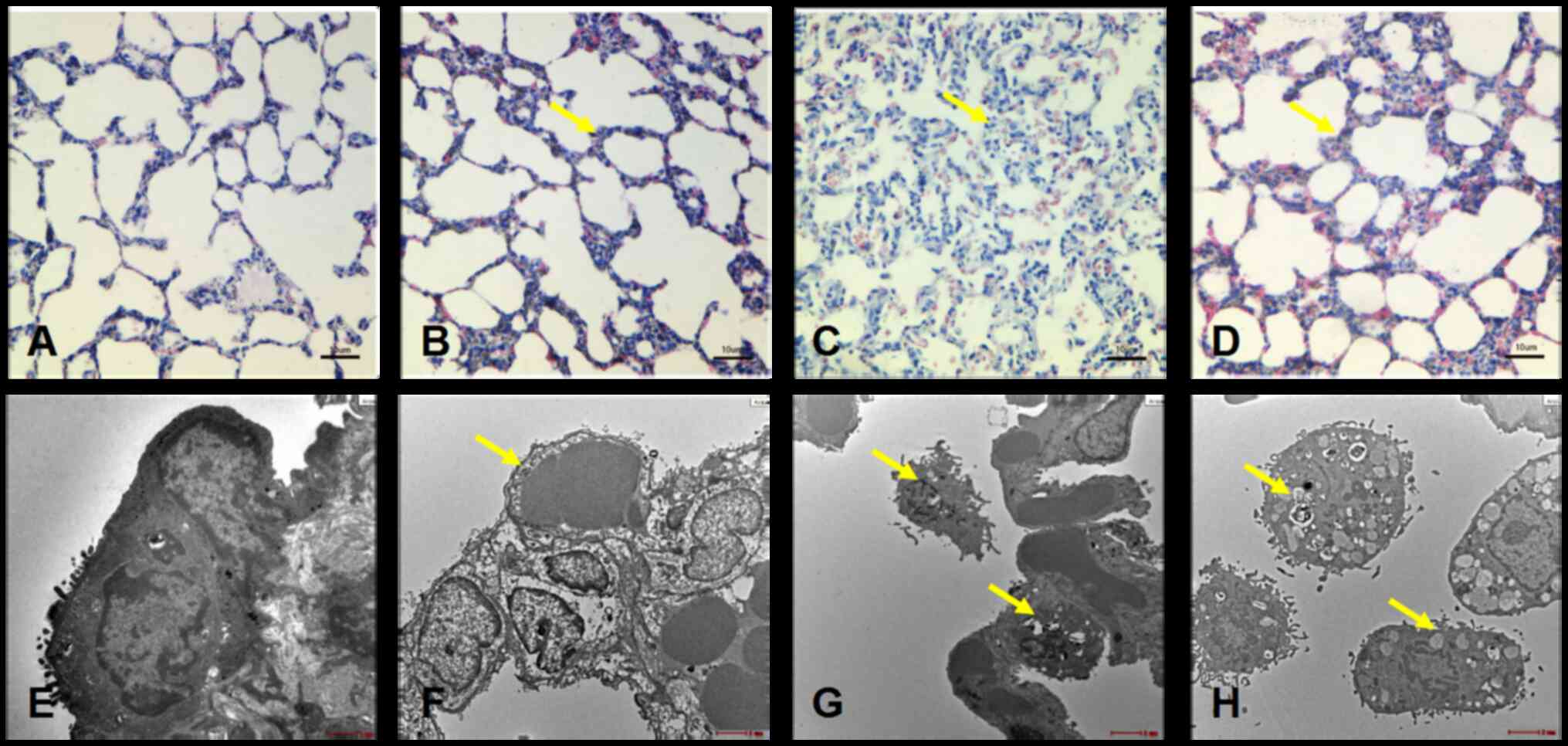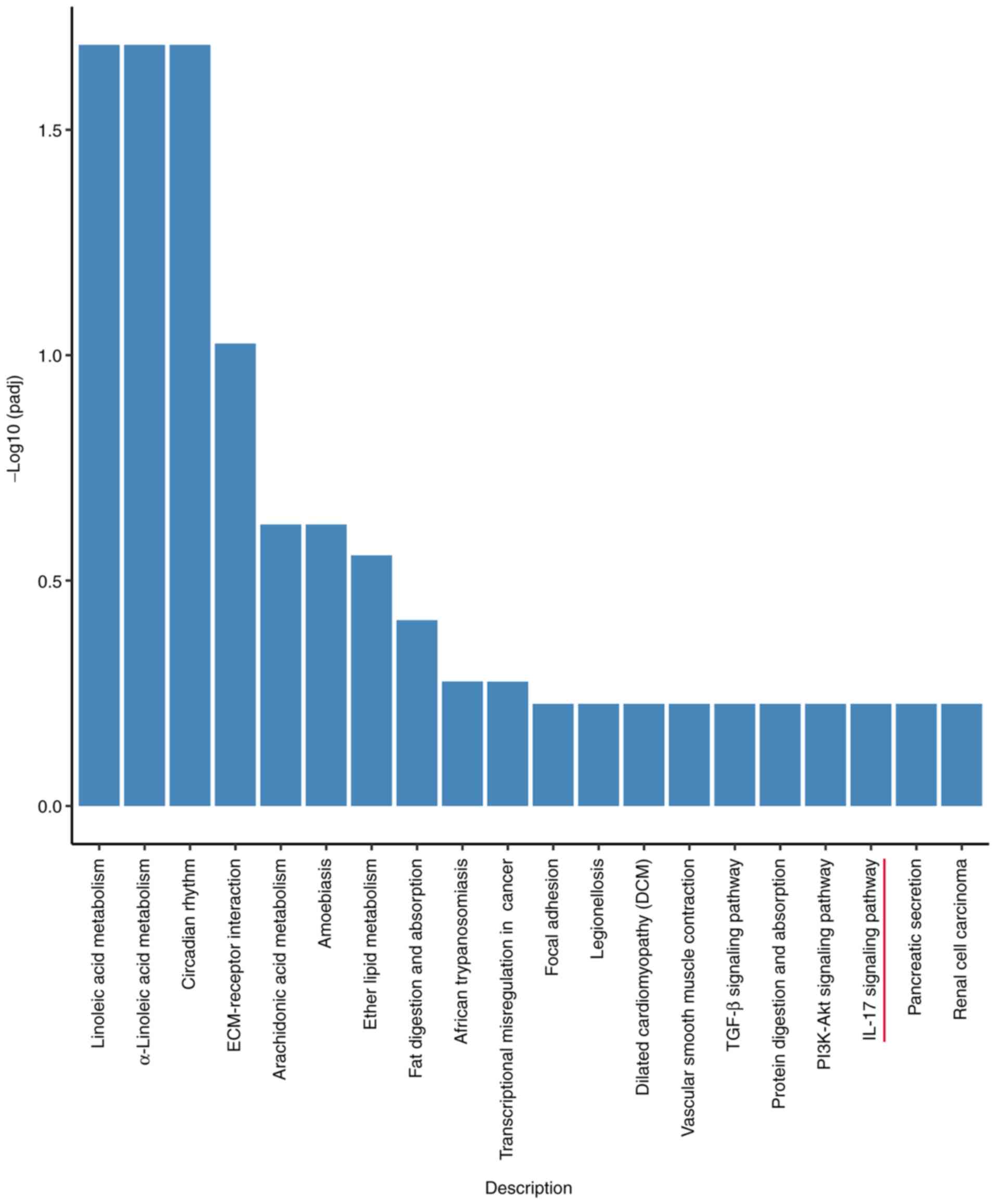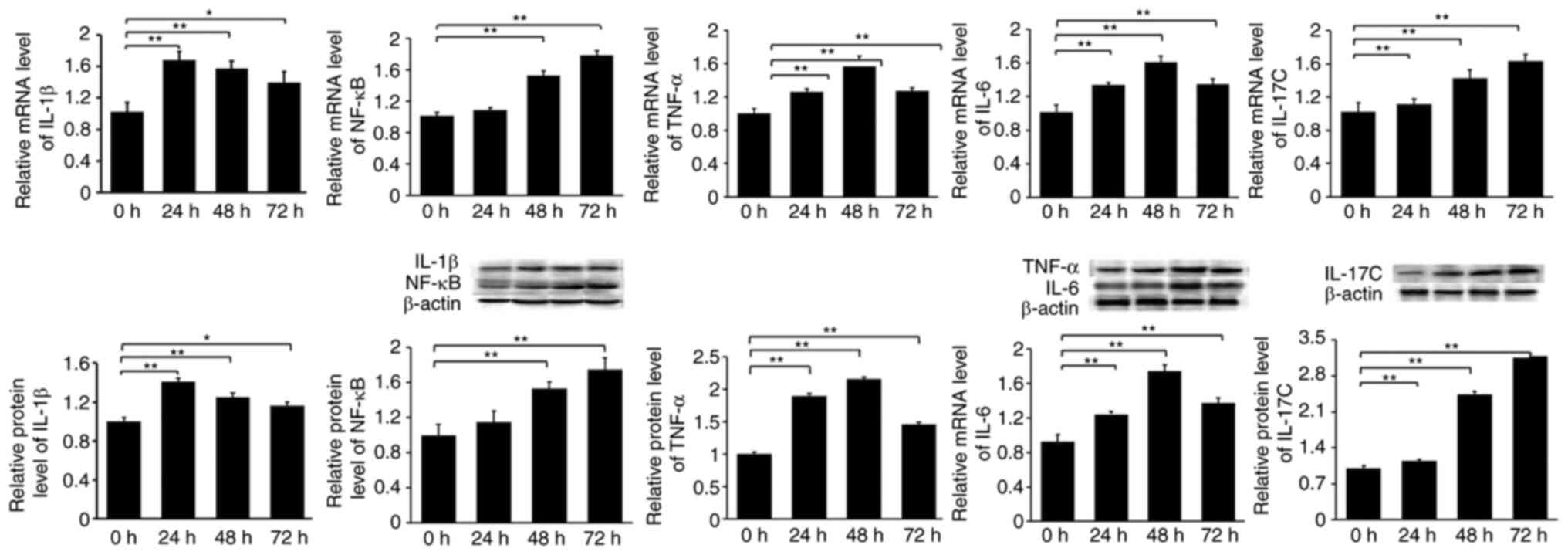|
1
|
Tang E, Chen Y and Luo Y: Dexamethasone
for the prevention of acute mountain sickness: Systematic review
and meta-analysis. Int J Cardiol. 173:133–138. 2014. View Article : Google Scholar : PubMed/NCBI
|
|
2
|
Guo P, Luo H, Fan Y, Luo Y and Zhou Q:
Establishment and evaluation of an experimental animal model of
high altitude cerebral edema. Neurosci Lett. 547:82–86. 2013.
View Article : Google Scholar : PubMed/NCBI
|
|
3
|
Swenson ER, Maggiorini M, Mongovin S,
Gibbs JS, Greve I, Mairbäurl H and Bärtsch P: Pathogenesis of
high-altitude pulmonary edema: Inflammation is not an etiologic
factor. JAMA. 287:2228–2235. 2002. View Article : Google Scholar : PubMed/NCBI
|
|
4
|
Zhao S, Zhang L, Lian G, Wang X, Zhang H,
Yao X, Yang J and Wu C: Sildenafil attenuates LPS-induced
pro-inflammatory responses through down-regulation of intracellular
ROS-related MAPK/NF-κB signaling pathways in N9 microglia. Int
Immunopharmacol. 11:468–474. 2011. View Article : Google Scholar : PubMed/NCBI
|
|
5
|
Wyse C, Cathcart A, Sutherland R, Ward S,
McMillan L, Gibson G, Padgett M and Skeldon K: Effect of maximal
dynamic exercise on exhaled ethane and carbon monoxide levels in
human, equine, and canine athletes. Comp Biochem Physiol A Mol
Integr Physiol. 141:239–246. 2005. View Article : Google Scholar : PubMed/NCBI
|
|
6
|
Balan DJ, Rajavel T, Das M, Sathya S,
Jeyakumar M and Devi KP: Thymol induces mitochondrial
pathway-mediated apoptosis via ROS generation, macromolecular
damage and SOD diminution in A549 cells. Pharmacol Rep. 73:240–254.
2021. View Article : Google Scholar : PubMed/NCBI
|
|
7
|
Ma Y, Wang D, Xu X, Yang X, Wang X, Zhu Z,
Zhao Y, Chen M, Xu F, Fu L, et al: Dynamic changes of ROS, MDA and
SOD during arsenic-induced neoplastic transformation in human
keratinocytes. Wei Sheng Yan Jiu. 44:456–461. 2015.(In Chinese).
PubMed/NCBI
|
|
8
|
Zi Y, Jiang B, He C and Liu L: Lentinan
inhibits oxidative stress and inflammatory cytokine production
induced by benzo(a)pyrene in human keratinocytes. J Cosmet
Dermatol. 19:502–507. 2020. View Article : Google Scholar : PubMed/NCBI
|
|
9
|
Altamura S, Bärtsch P, Dehnert C,
Maggiorini M, Weiss G, Theurl I, Muckenthaler MU and Mairbäurl H:
Increased hepcidin levels in high-altitude pulmonary edema. J Appl
Physiol (1985). 118:292–298. 2015. View Article : Google Scholar : PubMed/NCBI
|
|
10
|
Gao H, Liu L, Zhao Y, Hara H, Chen P, Xu
J, Tang J, Wei L, Li Z, Cooper DK, et al: Human IL-6, IL-17, IL-1β,
and TNF-α differently regulate the expression of pro-inflammatory
related genes, tissue factor, and swine leukocyte antigen class I
in porcine aortic endothelial cells. Xenotransplantation. 24:2017.
View Article : Google Scholar
|
|
11
|
Sun Y, Hu G, Zhang X and Minshall RD:
Phosphorylation of caveolin-1 regulates oxidant-induced pulmonary
vascular permeability via paracellularand transcellular pathways.
Circ Res. 105:676–685. 2009. View Article : Google Scholar : PubMed/NCBI
|
|
12
|
Shukla D, Saxena S, Jayamurthy P, Sairam
M, Singh M, Jain SK, Bansal A and Ilavazaghan G: Hypoxic
preconditioning with cobalt attenuates hypobaric hypoxia-induced
oxidative damage inratlungs. High Alt Med Biol. 10:57–69. 2009.
View Article : Google Scholar : PubMed/NCBI
|
|
13
|
Gonzalez NC and Wood JG: Leukocyte
endothelial interactions in environmental hypoxia. Adv Exp Med
Biol. 502:39–60. 2001. View Article : Google Scholar : PubMed/NCBI
|
|
14
|
Xiao-Lin MA, Jin RB, Zhang XH, Cui GY, Ren
XJ, Shi H and Sun YQ: Study on management of 726 victims in
military hospitals following Yushu earthquake in Qinghai province.
J Traumat Surg. 4:339–343. 2010.(In Chinese).
|
|
15
|
Tang C, Luo Y, Li S, Huang B, Xu S and Li
L: Characteristics of inflammation process in monocrotaline-induced
pulmonary arterial hypertension in rats. Biomed Pharmacother.
133:1110812021. View Article : Google Scholar : PubMed/NCBI
|
|
16
|
Han Z, Li X, Cui X, Yuan H and Wang H: The
roles of immune system and autoimmunity in pulmonary arterial
hypertension: A review. Pulm Pharmacol Ther 102094. Nov
2–2021.(Epub ahead of print). View Article : Google Scholar : PubMed/NCBI
|
|
17
|
Hu DL, Yu YX, Liang R, Zhou SY, Duan SL,
Jiang ZY, Meng CY, Jiang W, Wang H, Sun YX and Fang LS: Regulation
of hypoxia inducible factor-1α on permeability of vascular
endothelial cells and the mechanism. Zhonghua Shao Shang Za Zhi.
35:209–217. 2019.(In Chinese). PubMed/NCBI
|
|
18
|
Zhou Q, Luo Y, Li H, Li S, Zhang X, Gao W,
Zheng B, Yang D, Liu F and Yuqi G: Epidemiological study of
mountain sickness complicated with multiple organ dysfunction
syndrome on the Qinghai-Tibetan Plateau: report of 103 cases. Sci
Res Essays. 5:2010.
|
|
19
|
Althubiti M, Rada M, Samuel J, Escorsa JM,
Najeeb H, Lee KG, Lam KP, Jones GD, Barlev NA and Macip S: BTK
modulates p53 activity to enhance apoptotic and senescent
responses. Cancer Res. 76:5405–5414. 2016. View Article : Google Scholar : PubMed/NCBI
|
|
20
|
Barbarulo A, Grazioli P, Campese AF,
Bellavia D, Di Mario G, Pelullo M, Ciuffetta A, Colantoni S, Vacca
A, Frati L, et al: Notch3 and canonical NF-kappaB signaling
pathways cooperatively regulate Foxp3 transcription. J Immunol.
186:6199–6206. 2011. View Article : Google Scholar : PubMed/NCBI
|
|
21
|
Li H, Chen J, Huang A, Stinson J, Heldens
S, Foster J, Dowd P, Gurney AL and Wood WI: Cloning and
characterization of IL-17B and IL-17C, two new members of the IL-17
cytokine family. Proc Natl Acad Sci USA. 97:773–778. 2000.
View Article : Google Scholar : PubMed/NCBI
|
|
22
|
Song X, He X, Li X and Qian Y: The roles
and functional mechanisms ofinterleukin-17 family cytokines in
mucosal immunity. Cell Mol Immunol. 13:418–431. 2016. View Article : Google Scholar : PubMed/NCBI
|
|
23
|
Song X, Zhu S, Shi P, Liu Y, Shi Y, Levin
SD and Qian Y: IL-17RE is the functional receptor for IL-17C and
mediates mucosal immunity to infection with intestinal pathogens.
NatImmunol. 12:1151–1158. 2011.
|
|
24
|
Akitsu A and Iwakura Y:
Interleukin-17-producing γδ T (γδ17) cells in inflammatory
diseases. Immunology. 155:418–426. 2018. View Article : Google Scholar : PubMed/NCBI
|
|
25
|
Yamaguchi Y, Fujio K, Shoda H, Okamoto A,
Tsuno NH, Takahashi K and Yamamoto K: IL-17B and IL-17C are
associated with TNF-alpha production and contribute to the
exacerbation of inflammatory arthritis. J Immunol. 179:7128–7136.
2007. View Article : Google Scholar : PubMed/NCBI
|
|
26
|
Ruiz de Morales JMG, Puig L, Daudén E,
Cañete JD, Pablos JL, Martín AO, Juanatey CG, Adán A, Montalbán X,
Borruel N, et al: Critical role of interleukin (IL)-17 in
inflammatory and immune disorders: An updated review of the
evidence focusing in controversies. Autoimmun Rev. 19:1024292020.
View Article : Google Scholar : PubMed/NCBI
|
|
27
|
Yu S, Luo X, Yang B, Xiao L, Wu X, Li H
and Wu C: Poly-functional T helper cells in human tonsillar
mononuclear cells. Eur Cytokine Netw. 30:114–122. 2019.PubMed/NCBI
|
|
28
|
De-Doncker L, Picquet F, Petit J and
Falempin M: Characterization of spindle afferents in rat soleus
muscle using ramp-and-hold and sinusoidal stretches. J
Neurophysiol. 89:442–449. 2003. View Article : Google Scholar : PubMed/NCBI
|
|
29
|
Kanehisa M and Goto S: KEGG: Kyoto
encyclopedia of genes and genomes. Nucleic Acids Res. 28:27–30.
2000. View Article : Google Scholar : PubMed/NCBI
|
|
30
|
Livak KJ and Schmittgen TD: Analysis of
relative gene expression data using real-time quantitative PCR and
the 2(−Delta Delta C(T)) method. Methods. 25:402–408. 2001.
View Article : Google Scholar : PubMed/NCBI
|
|
31
|
Ryan CF, Lowe AA and Fleetham JA: Nasal
continuous positive airway pressure (CPAP) therapy for obstructive
sleep apnea in Hallermann-Streiff syndrome. Clin Pediatr (Phila).
29:122–124. 1990. View Article : Google Scholar : PubMed/NCBI
|
|
32
|
Maggiorini M, Mélot C, Pierre S, Pfeiffer
F, Greve I, Sartori C, Lepori M, Hauser M, Scherrer U and Naeije R:
High-altitude pulmonary edema is initially caused by an increase in
capillary pressure. Circulation. 103:2078–2083. 2001. View Article : Google Scholar : PubMed/NCBI
|
|
33
|
Luo X, Guo W, Xu R, et al: Effect of high
altitude and hypoxia in simulated environment on HPT axis and
expression of VEGF and HIF-1 in lung tissues of rats. Acad J Chin
PLA Med Sch. 37:864–868. 2016.(In Chinese).
|
|
34
|
Guo W: The dynamic observation of
hypothalamic-pituitary-adrenala axis/hypothalamic-pituitary-thyroid
axis stress and the effect of lung and brain tissue under simulated
high altitude hypoxia. Gan Su University of Chinese Medicine; 2016,
(In Chinese).
|
|
35
|
Li Y: The research of hypoxia related
genes in high altitude pulmonary edema. Qing Hai University; 2017,
(In Chinese).
|
|
36
|
Brandon M, Baldi P and Wallace DC:
Mitochondrial mutations in cancer. Oncogene. 25:4647–4662. 2006.
View Article : Google Scholar : PubMed/NCBI
|
|
37
|
Morrow JD: Quantification of isoprostanes
as indices of oxidant stress and the risk of atherosclerosis in
humans. Arterioscler Thromb Vasc Biol. 25:279–286. 2005. View Article : Google Scholar : PubMed/NCBI
|
|
38
|
Zhou L, Aon MA, Almas T, Cortassa S,
Winslow RL and O'Rourke B: A reaction-diffusion model of
ROS-induced ROS release in a mitochondrial network. PLoS Comput
Biol. 6:e10006572010. View Article : Google Scholar : PubMed/NCBI
|
|
39
|
Xiong R, Jiang W, Li N, Liu B, He R, Wang
B and Geng Q: PM2.5-induced lung injury is attenuated in
macrophage-specific NLRP3 deficient mice. Ecotoxicol Environ Saf.
221:1124332021. View Article : Google Scholar : PubMed/NCBI
|
|
40
|
Ramirez-Carrozzi V, Sambandam A, Luis E,
Lin Z, Jeet S, Lesch J, Hackney J, Kim J, Zhou M, Lai J, et al:
IL-17C regulates the innate immune function of epithelial cells in
an autocrine manner. Nat Immunol. 12:1159–1166. 2011. View Article : Google Scholar : PubMed/NCBI
|
|
41
|
Uberti F, Lattuada D, Morsanuto V, Nava U,
Bolis G, Vacca G, Squarzanti DF, Cisari C and Molinari C: Vitamin D
protects human endothelial cells from oxidative stress through the
autophagic and survival pathways. J Clin Endocrinol Metab.
99:1367–1374. 2014. View Article : Google Scholar : PubMed/NCBI
|

















